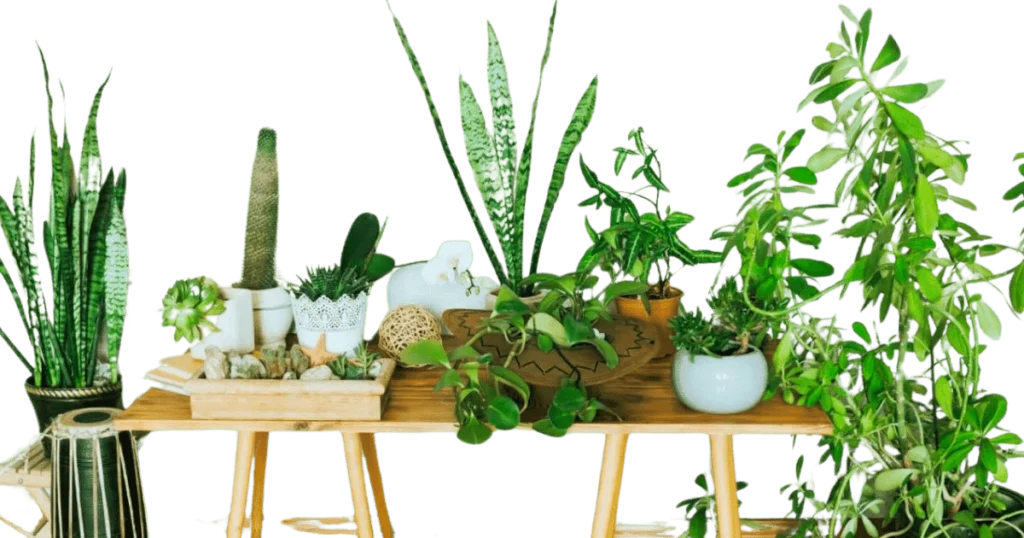The Indoor Plant Resurgence
In recent years, indoor plants have experienced a remarkable resurgence in popularity. Beyond being mere home decorations, these leafy companions have become essential elements in modern interior design. This article delves deep into them, exploring their beauty, impact on our well-being, and the fascinating science behind them.

Aesthetic Delight: The Beauty of Indoor Plants
The visual appeal of indoor plants is undeniable. They introduce a natural element into your living areas, establishing an ambiance of serenity and unity. The variety of indoor plant species allows you to choose those that align with your style and the atmosphere you desire to establish. Whether it’s the elegant fronds of a Boston Fern, the dramatic leaves of a Fiddle Leaf Fig, or the delicate flowers of an orchid, they serve as captivating centerpieces in any room.
Furthermore, they are incredibly adaptable. They can thrive in various lighting conditions, from bright, indirect sunlight to low-light corners, making them suitable for every part of your home. The presence of indoor plants can transform a space into a sanctuary, connecting to nature and enhancing your overall decor.
Health and Well-being: Indoor Plants as Natural Healers
They offer more than just visual appeal. They are natural air purifiers. Numerous studies, including NASA’s Clean Air Study, have revealed that certain indoor plants can effectively remove common indoor pollutants, such as formaldehyde, benzene, and xylene. Snake plants, spider plants, and peace lilies are among the champions of air purification, ensuring the air you breathe is cleaner and healthier.
Besides enhancing air quality, they have been associated with various positive effects on health. They can alleviate stress, decrease blood pressure, and boost productivity. Nurturing plants fosters a sense of duty and a connection to the natural world, offering valuable therapeutic benefits in our fast-paced, contemporary lifestyles.
Sustainability: Greening Your Home Responsibly
The growing popularity of these plants aligns with a broader focus on sustainability and eco-friendliness. By incorporating more greenery into our homes, we take a small but meaningful step towards environmental consciousness. Indoor plants provide a source of renewable beauty and promote responsible consumption.
In addition to improving air quality, indoor plants have been linked to numerous favorable impacts on well-being. They have the potential to reduce stress, lower blood pressure, and enhance productivity. Tending to plants nurtures a feeling of responsibility and a bond with the environment, delivering valuable therapeutic advantages in our increasingly fast-paced modern lives.
Types of Indoor Plants
Low-Maintenance Legends: Perfect for Beginners
If you’re new to indoor gardening, some plants are more forgiving than others. Consider starting with snake plants, ZZ plants, or hardy pothos. These low-maintenance legends are known for their resilience and can thrive in various conditions.
Statement Makers: Bold and Beautiful
For those who want to make a design statement, consider plants like the Fiddle Leaf Fig, Monstera, or Bird of Paradise. These striking specimens will turn heads and become the focal point of your decor.
Air-Purifying Powerhouses: Health and Beauty Combined
To improve your indoor air quality, choose plants like peace lilies, spider plants, and rubber plants. They not only enhance the aesthetics of your space but also work tirelessly to keep the air clean and fresh.
The Art and Science of Indoor Plant Care
Caring for them is both an art and a science. It involves understanding their needs, from light and water to humidity and nutrients. Here are some essential tips to ensure your indoor plants thrive:
Light Requirements For Indoor Plants
Different plants have varying light requirements. Some thrive in bright, indirect light, while others are adapted to low-light conditions. Understand your plant’s preferences and place it accordingly.
Watering
Overwatering and underwatering are common pitfalls. It’s crucial to strike the right balance. Some plants prefer to dry out between waterings, while others like consistently moist soil. Be mindful of your plant’s watering needs.
Humidity
Indoor plants often benefit from higher humidity levels. You can increase humidity by misting your plants, using a humidity tray, or placing a humidifier nearby.
Fertilization For Indoor plants
Indoor plants require nutrients for growth. Use a balanced, water-soluble fertilizer and follow the recommended feeding schedule for your specific plant.
Pest Control
Look for common indoor plant pests like aphids, mealybugs, and spider mites. Early detection and treatment are essential to protecting your plants.
| Plant Name | Benefits | Care Tips |
|---|---|---|
| Fiddle Leaf Fig | Air purification, aesthetic appeal | Bright, indirect light; water when top inch of soil is dry |
| Snake Plant | Improves air quality, low maintenance | Low light, infrequent watering |
| Spider Plant | Removes air pollutants, easy to grow | Indirect light, keep soil evenly moist |
Frequently Asked Questions (FAQs) related to indoor plants and greening your home:
Why should I consider having indoor plants in my home?
Indoor plants not only enhance the aesthetic appeal of your space but also contribute to improved air quality and overall well-being. They bring a touch of nature indoors.
What are the benefits of having indoor plants?
Indoor plants can purify the air, reduce stress, boost productivity, and create a more pleasant environment. They also add a natural element to your decor.
Which indoor plants are suitable for beginners?
Beginner-friendly plants include snake plants, spider plants, and pothos. These are low-maintenance and can thrive in various conditions.
How much light do indoor plants need?
The light requirements vary among plants, but most indoor plants thrive in bright, indirect light. Some can tolerate lower light conditions, making them versatile for different spaces.
How often should I water my indoor plants?
The watering frequency depends on the type of plant and environmental factors. Generally, it’s best to let the top inch of soil dry out before watering.
Can indoor plants improve air quality?
Yes, many indoor plants are known for their air-purifying properties. They can help filter out common pollutants and toxins, promoting a healthier indoor environment.
What are some creative ways to display indoor plants in my home?
Consider using stylish planters, hanging baskets, or creating a dedicated plant corner. Mix and match different plant varieties to add visual interest.
How do I prevent common issues like overwatering or pests with indoor plants?
Ensure proper drainage for your plants, avoid overwatering by checking soil moisture, and regularly inspect plants for signs of pests. Taking preventive measures is key.
Are there indoor plants safe for households with pets?
Yes, many indoor plants are pet-friendly. Some examples include spider plants, Boston ferns, and areca palms. However, it’s essential to research specific plants, as some can be toxic to pets.
Can indoor plants thrive in low-light conditions?
Yes, several indoor plants, such as snake plants and ZZ plants, are known for their ability to thrive in low-light environments. However, providing some natural light is generally beneficial for most indoor plants.
Conclusion
In conclusion, indoor plants are much more than decorative elements; they are living, breathing companions that enrich our lives in numerous ways. They enhance the aesthetic charm of our residences, improve our overall health and welfare, and promote eco-friendly living. If you haven’t done so already, contemplate incorporating some verdant elements into your indoor sanctuary to encounter their profound influence of them. Cultivate tranquility and embrace the beauty and science of indoor gardening.


buy viagra pills online uk